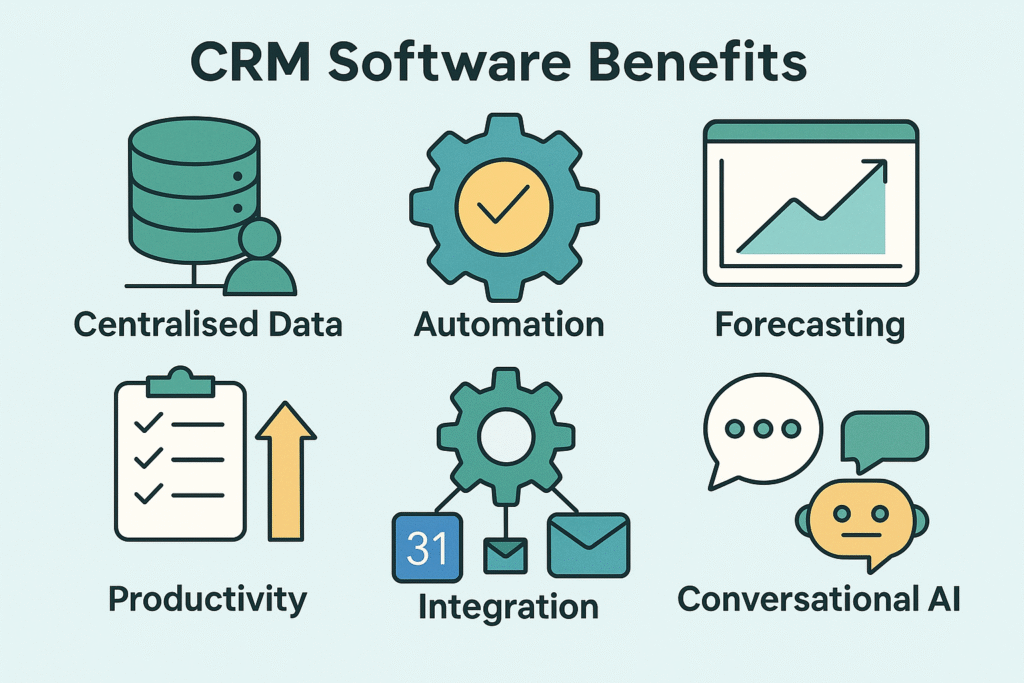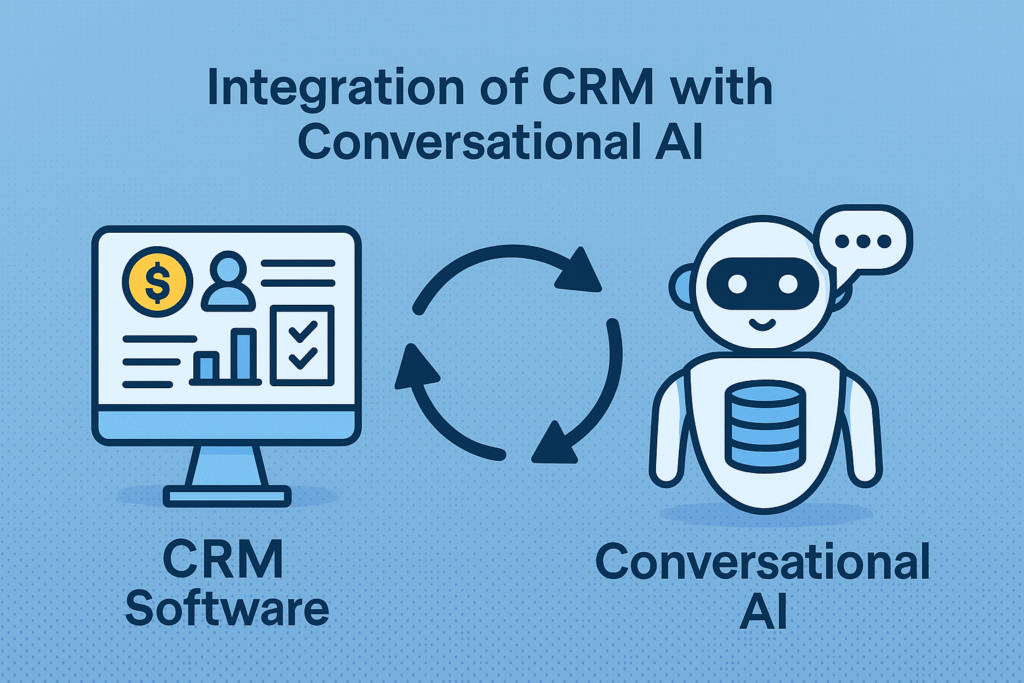Top 15 CRM software platforms in 2025
- July 7th, 2025 / 5 Mins read
-
 Aarti Nair
Aarti Nair

Top 15 CRM software platforms in 2025
- July 7th, 2025 / 5 Mins read
-
 Aarti Nair
Aarti Nair
You’ve just taken on a new sales territory, and your first week is already a whirlwind of missed follow-ups, scattered spreadsheets and a cluttered inbox. Sound familiar?
Meet Priya, a sales executive who found herself in exactly that maze last year. Every time she chased a lead, another slipped through the cracks and with no single source of truth, her days felt more reactive than strategic.
That story isn’t unique. According to recent research, only 13% of businesses have made investing in a CRM system their number one sales goal. Yet among companies struggling to close deals, three-quarters believe that a well-structured CRM paired with an efficient sales funnel could boost their revenue. In other words, the very tool many dismiss as “just another database” often proves the difference between hitting targets and falling short.
Over the next few sections, we’ll explore 15 CRM platforms that have gained traction in 2025, each chosen for its blend of usability, integration and measurable impact on sales performance. Whether you’re looking to streamline lead management like Priya did, automate routine tasks or gain real-time insights on customer behaviour, there’s a system here to suit your team’s needs. Let’s dive in.
What Is CRM Software?
At its core, Customer Relationship Management (CRM) software acts as a central hub for all your interactions with prospects and customers. Think of it as a digital Rolodex crossed with a project tracker. It automatically logs emails, schedules follow-ups and surfaces insights on buying behaviour.
Using CRM software you can get:
Unified view of contacts: Rather than hunting through spreadsheets or shifting between apps, you see every touchpoint, like calls, emails and meetings, all in one place.
Automated reminders: No more sticky notes or calendar collisions. The system prompts you when it’s time to reach out.
Pipeline visibility: From initial outreach to closed deal, you can measure which stages need attention and where leads tend to stall.
Data-driven decisions: Built-in reports reveal patterns, such as which channels yield the strongest leads, so your next move isn’t a guess.
It’s little wonder that 91% of companies with ten or more employees now rely on CRM software to keep their sales engine running smoothly. When everyone on the team works from the same playbook, you replace guesswork with a clear path to growth.
Why CRM Software Is Important?
Having seen what CRM software does, it’s worth examining why so many teams find it indispensable:
1. Eliminate Fragmented Data Silos
When you rely on spreadsheets, email threads and scattered notes, it’s all too easy to lose track of whom you’ve contacted or what was discussed. A CRM centralises every interaction, like calls, meetings, emails and documents, into a single record. That means no more hunting through multiple tools to find a customer’s history, so your team spends less time searching and more time selling.
2. Drive Revenue Growth
By ensuring every opportunity is recorded and progressed, CRMs help teams to follow up consistently and spot upsell or cross-sell moments. In fact, companies report up to a 29% increase in sales once their team fully adopts a CRM. It’s the difference between reacting to prospects and proactively nurturing them through an efficient sales funnel.
3. Enhance Sales Productivity
Manual data entry and reminder-setting eat into a salesperson’s day. CRM automation takes over these repetitive tasks, logging every email, setting follow-up prompts and even scoring leads based on activity. As a result, sales reps reclaim up to 34% of their time, freeing them to focus on high-value calls and personalised outreach.
4. Strengthen Forecast Accuracy
When pipeline stages update in real time, your forecast reflects what’s actually happening rather than outdated guesses. With a CRM, companies see up to a 42% improvement in their ability to predict revenue. That level of precision lets managers allocate resources confidently, adjust targets as needed and avoid last-minute surprises.
5. Gain Deeper Customer Insights
A unified customer record collected over time reveals patterns in preferences, purchase behaviour and support needs. Three-quarters (74%) of users say their CRM gives them better access to this data, so your team can tailor conversations, anticipate questions and resolve issues faster. In practice, that means more personalised service and stronger customer loyalty.
Key Features to Look for When Adopting CRM Software
Choosing the right CRM means evaluating more than just contact lists. Here are the essentials and how each one makes a tangible difference to your team’s performance.
Intuitive Interface
A clutter-free dashboard means your team spends seconds and not minutes for finding contacts or updating deal stages. When the system feels familiar from day one, reps log every call and note without second-guessing, so your data stays current and complete.
Seamless Integrations
Your CRM should pull in activity from email, calendar, marketing tools and payment platforms without you lifting a finger. Picture a new lead filling out a form on your website: within moments, their details appear in the CRM, you see their email opens, and any purchase activity shows up alongside. No manual imports, no transcription errors.
Tailored Workflows
Out of the box, most CRMs offer a simple pipeline, but every business has its own rhythm. Dragging stages to match your sales process means that whether you’re qualifying, negotiating or renewing, every opportunity follows the right path. That way, your team never has to invent workarounds.
Insightful Analytics
Rather than staring at raw data, you need clear answers:
- Which deals are at risk
- Which campaigns drive the best leads?
With built-in charts and clickable reports, you can spot bottlenecks and high-performing reps at a glance and then bridge those insights straight into your next coaching session.
Smart Automation
Imagine every new lead scoring itself, tailored emails firing off at the ideal moment, and to-do reminders landing in reps’ queues without anyone typing a thing. That’s automation turning routine admin into a background process, so your people focus on conversations, not data entry.
Mobile Accessibility
Deals don’t pause when you step away from your desk. A fully featured mobile app keeps customer notes, call scripts and pipeline views at your fingertips, whether you’re travelling between offices or catching up on calls from a coffee shop.
Built-in Security and Compliance
With role-based permissions, encryption and audit trails, you lock down sensitive customer information while still letting each team member see exactly what they need. That balance keeps your data safe and your organisation onside with GDPR or any local regulations.
Conversational AI
Finally, look for CRMs that come with chatbots or voice assistants already wired in. These tools field routine enquiries like product FAQs or appointment bookings, and log every interaction straight back to the customer record. Over time, the AI learns which prompts convert, guiding prospects through your funnel even when your team is offline.
Or an AI chatbot solution that easily integrates with CRM solutions.
Top 15 CRM Software Platforms in 2025
Below is a curated list of 15 CRM solutions that stand out this year. For each, you’ll find key strengths and potential drawbacks to help you match the right tool to your team’s needs.
1. Salesforce Sales Cloud
Sales Cloud lets you tailor your interface with Salesforce LWC (Lightning Web Components), so you can embed interactive charts and simplified layouts that work seamlessly on desktop and mobile. You can plug in external portals via REST APIs to have partner deals flow directly into your CRM, cutting out tedious data entry. And with automated reports running each morning, your team wakes up to a clear snapshot of quotas, forecasts and key performance indicators—no manual updates required. Beyond these capabilities, the AppExchange ecosystem offers hundreds of add-ons, from marketing automation to finance connectors, ensuring your CRM evolves as your needs do.
Pros
Custom dashboards and embedded charts deliver precise, real-time insights
Powerful analytics reveal trends and bottlenecks at a glance
Scales effortlessly from a handful of users to thousands
Cons
Requires expertise in Lightning Web Components, adding to the learning curve
Licensing and implementation costs can be steep for smaller teams
Customisation is largely confined to Salesforce’s proprietary framework, limiting free-form coding options.
2. HubSpot CRM
HubSpot CRM greets you with a clean, drag-and-drop interface that feels familiar from the moment you log in. Even on the free tier, you get email tracking, deal pipelines and task reminders, so small teams can manage leads and follow-ups without juggling multiple tools. Built-in marketing automation and content tools let you launch campaigns, track engagement and feed activity straight back into the same system—no extra licences required. As reviews note, this streamlined approach “saves a lot of time when handling multiple clients” and delivers a professional sales process without the overwhelm.
Pros
Intuitive interface that requires minimal training
Generous free tier covering core sales and marketing workflows
Native marketing automation and content tools, plus integrations with Gmail, Zoom and Slack
Cons
Reporting and custom-field options are limited on lower tiers
Advanced features (multiple pipelines, custom reports, complex workflows) sit behind higher-cost plans
Some integrations (for example, Outlook) can suffer reliability issues unless you upgrade or troubleshoot regularly
3. Zoho CRM
Zoho CRM brings a full 360° view of your customer lifecycle into one cloud-based platform. As soon as you type a few letters into its search bar, contacts and accounts pop up—no more endless scrolling. Built-in automation handles routine tasks like follow-up emails and lead scoring, while Zia, the AI assistant, flags anomalies and suggests which prospects to prioritise next. Behind the scenes, Zoho ties together your marketing campaigns, support tickets and inventory data, so every department works from the same playbook.
Pros
Competitive pricing paired with a broad feature set, from sales funnels to inventory management
Seamless integration across the Zoho ecosystem (Desk, Campaigns, and 500+ other apps)
AI-driven assistant for predictive insights and task recommendations
Cons
User interface can feel cluttered or dated, making navigation less intuitive
Some advanced tools, such as deeper analytics or custom modules, require higher-tier subscriptions
Occasional delays in customer-support responses can slow down issue resolution
4. Microsoft Dynamics 365 Sales
Linking your inbox and calendar has never been smoother: with Dynamics 365 Sales, every email in Outlook and every chat in Teams feeds directly into your opportunity records. As you schedule calls or log notes, the system’s AI-driven insights surface which leads are heating up and which deals need a nudge—so you spend time on the right conversations. Behind the scenes, Power Platform lets you build custom apps and automate processes without waiting on IT, whether that’s a bespoke dashboard for your finance team or a workflow that nudges marketing when an opportunity reaches a certain value.
Pros
Native Office 365 and Teams integration keeps communications and CRM in one place
AI-powered forecasting and insights help you anticipate revenue and prioritise high-value deals
Power Platform customisation allows low-code apps and automations to match your exact processes
Cons
Setup and administration demand dedicated resources and technical know-how
Feature depth can overwhelm smaller teams without a clear implementation plan
Additional licences or custom development quickly increase the total cost
5. Pipedrive
With Pipedrive’s visual pipeline, you see every deal move from ‘Contact Made’ to ‘Won’ in a single glance. Activity-based selling keeps your to-do list front and centre—tasks, calls and emails pop up exactly when you need them—so nothing falls through the cracks. Email integration links your inbox directly to Pipedrive, automatically logging conversations against the right contact. Behind the scenes, AI-powered recommendations suggest which deals to prioritise, and a straightforward setup means even a small team is up and running in hours rather than days.
Pros
Visual, drag-and-drop pipeline lets reps track deals intuitively
Rapid onboarding and simple configuration get teams selling fast
Activity-based reminders focus reps on the next best action
Cons
Lacks built-in marketing automation or advanced nurture tools
Reporting is basic and doesn’t support fully custom dashboards
Smaller ecosystem means fewer third-party integrations compared to major CRMs
6. Freshsales (by Freshworks)
Freshsales unites phone, email and chat into a single workspace, so you can call prospects from your browser and have every conversation logged automatically against the right contact. Its AI-powered lead scoring highlights high-potential deals, while deal insights surface which accounts need attention next. A clean, modern interface guides you through your pipeline stages, and automation sequences handle routine follow-ups—leaving you free to focus on high-value conversations.
Pros
Native phone and email capabilities mean no third-party diallers or plugins
AI-driven lead scoring and deal insights prioritise your busiest opportunities
Sleek, intuitive interface reduces training time
Cons
Customisation options are limited on entry-level plans
Reporting module can feel clunky and unintuitive
Mobile app lacks some desktop features, such as advanced deal editing
7. Copper
Because Copper lives inside Google Workspace, every email, calendar event and contact you already use turns into CRM data without extra steps. When a new lead fills in your website form or you scan a business card with the mobile app, Copper auto-syncs the information into your pipeline. You drag deals through stages, and tasks and next-step reminders appear alongside the client record—no toggling between tabs. As you close a deal, one click moves that contact into your onboarding or project pipeline, keeping sales and delivery aligned.
Pros
Deep Google Workspace integration means contacts and events auto-populate your CRM
Minimal data entry lets small teams ramp up quickly
Clean, straightforward design keeps focus on moving deals forward
Cons
Lacks the flexibility needed for complex, multi-stage sales processes
Automation options are limited compared to more specialised platforms
Reporting and analytics remain basic, with few customisation choices
8. Insightly
Insightly brings your sales pipeline and project delivery into one workspace. As soon as a lead converts, you can spin up a project, assign tasks and track milestones alongside your opportunity stages—no hopping between separate tools. Customisable pipelines let you visualise both customer journeys and internal workflows, while relationship mapping surfaces key contacts across companies and projects. Teams appreciate that they can centralise everything from emails and quotes to project tasks in a single system that grows with them.
Pros
Built-in project management keeps sales and delivery aligned
Customisable pipelines and relationship maps help you visualise complex account structures
Mid-market pricing delivers advanced capabilities without enterprise-level costs
Cons
Interface can feel cluttered when balancing CRM and project views
Email marketing features are minimal, requiring external tools for campaigns
Project-CRM crossover features come with a learning curve for new users
9. Keap (formerly Infusionsoft)
Keap puts small businesses front and centre, combining CRM, marketing automation and e-commerce in one platform. From the moment a visitor fills in your lead capture form or clicks a link in a text message, Keap organises every contact into lists and tags. Built-in sales and marketing automation then nurtures those leads with email sequences, scoring hot prospects as they engage. When it comes to payment and invoicing, you can process orders, send quotes and track payments without leaving the same dashboard.
Pros
Purpose-built for small businesses, with marketing and sales automation under one roof
Native e-commerce and payment features simplify order processing and invoicing
Lead capture forms, tags and scoring workflows help you focus on the most engaged prospects
Cons
Initial setup and customisation can take considerable time and support
Full automation features require higher-tier plans, pushing up costs for growing teams
Email and campaign templates feel dated, and branding options can be limited without external add-ons
10. SugarCRM
With SugarCRM’s open-source core, you choose whether to run in the cloud or behind your own firewall—ideal if you need full control over data residency. Once deployed, its flexible architecture lets you tailor modules and workflows at the code level, so your sales, service and marketing processes align exactly with your business rules. Predictive insights bubble up through role-based dashboards, ensuring each team member sees only the metrics they need. And because Sugar’s security model is built on granular permissions, you can safeguard sensitive data without compromising collaboration.
Pros
Open-source foundation and flexible deployment give you full control over customisation and data
Robust role-based permissions and privacy controls to meet strict compliance requirements
Predictive analytics and unified dashboards deliver contextually relevant insights
Cons
Customisation demands technical expertise and developer resources
User interface and workflows feel less polished compared to cloud-native alternatives
Community-edition support can be slow, making rapid issue resolution challenging
11. monday CRM
monday Sales CRM centres all your customer information on a visual board where deals, contacts and tasks live side by side. You start by modelling your own sales stages with drag-and-drop columns, then layer in no-code automations to trigger notifications, assign tasks or update statuses the moment an action occurs. Built-in AI helps suggest next best steps, while custom dashboards and granular permissions ensure each team member sees only what’s relevant. With over 500 integrations—from email to accounting—data flows in automatically, keeping both sales and marketing working from the same, up-to-date playbook.
Pros
Flexible, visual boards adapt easily to your unique sales process
No-code automations and custom notifications reduce manual follow-ups
Centralised workspace unites sales, marketing and collaboration tools
Cons
Core feature set still evolving compared with longer-established CRMs
Reporting widgets offer limited depth without additional configuration
Pricing tiers and automation limits can become confusing as usage grows
12. Zendesk Sell
Zendesk Sell brings your sales and support teams together by feeding every lead, deal and task into the same platform that handles customer service. You can set up Sell in a matter of hours and immediately see how a fresh inquiry logged in Support becomes a deal in your sales pipeline—no manual handoffs required. Mobile-first design means reps logging calls or updating stages on the go never miss a beat, while built-in analytics give them a clear view of revenue metrics alongside service KPIs. Although it doesn’t replace dedicated marketing tools, Sell covers the essentials of lead and deal management within a single, unified workspace.
Pros
Seamless tie-in with Zendesk Support and Guide creates a full customer view
Straightforward setup and intuitive layout get teams selling fast
Mobile-first interface keeps reps productive outside the office
Cons
Marketing automation is minimal, so you’ll still need a specialist tool for campaigns
Most advanced reporting requires additional apps or add-ons
Customisation options are limited compared to larger, enterprise-grade CRMs.
13. Nimble
Nimble centres on relationships by pulling together contacts from Google Workspace, Microsoft 365 and your social channels into a single, enriched profile. As you work through a simple Kanban-style pipeline, tags and custom fields let you group contacts by project, sector or relationship stage. Intelligent reminders surface when it’s time to reconnect, and group messaging sends personalised outreach without manual list-building. Behind the scenes, Nimble’s social-media integration automatically fills in profile photos, job titles and company data—so you spend less time researching and more time engaging.
Pros
Deep social-media enrichment builds richer contact profiles without extra effort
Smart reminders and relationship insights keep you top of mind with key contacts
Affordable entry-level pricing makes it accessible for small teams
Cons
Pipeline management is basic and won’t scale for complex sales processes
Analytics are limited, with no advanced reporting dashboards
Not suitable for large enterprises that need extensive customisation or integration.
14. Agile CRM
Agile CRM wraps your sales, marketing and support workflows into a single, drag-and-drop interface. You can build multi-step automation that sends two-way emails, updates deal stages and spins up helpdesk tickets without touching code. Web analytics show which visitors linger on your pages, then convert them into contacts with one click. Integrated telephony means you dial prospects directly from the CRM and log call recordings alongside support requests, ensuring no handoffs fall through the cracks—all under one modern dashboard.
Pros
All-in-one platform covering sales, marketing automation and customer service
Built-in telephony and helpdesk modules eliminate the need for separate tools
Affordable pricing makes it accessible for small teams
Cons
The sheer number of features can feel overwhelming at first glance
Performance may lag when handling very large datasets
Advanced automation and reporting tools sit behind higher-tier plans
15. Bitrix24
Bitrix24 delivers CRM alongside chat, tasks, calendars and even HR tools in one consolidated workspace. You can capture leads in the same system where your team chats, assigns tasks on Kanban boards and tracks working hours on Gantt charts. If you need full control over your data, the self-hosted option keeps everything behind your firewall. For smaller teams, the generous free tier covers unlimited users—no hidden costs when your headcount grows.
Pros
All-in-one suite unites CRM, messaging, task management and HR features
Self-hosted deployment lets you maintain complete data control and compliance
Generous free tier supports unlimited users, making it budget-friendly for small teams
Cons
The breadth of features and settings can overwhelm non-technical users
Interface can feel cluttered, with many modules vying for attention
Email sending reliability varies, requiring additional setup or troubleshooting.
Integrating Conversational AI with Your CRM
When you weave a conversational AI solution into your CRM, you turn static customer profiles into living dialogues. By embedding Verloop’s AI-driven chatbots and voice assistants directly alongside your CRM data, you ensure every interaction—whether it’s a quick product query at 2 am or a detailed feature discussion during office hours—feeds back into the same sales funnel you’ve painstakingly built.
First, you cut manual data-entry out of routine enquiries. As soon as a prospect chats with your bot, their details, preferences and questions are logged automatically in your CRM. That means your team wakes up to qualified leads, not a backlog of transcripts to import.
Next, you ramp up responsiveness. Verloop’s conversational AI can resolve common issues, book meetings or guide visitors through demos instantly—so you capture interest at its peak. Meanwhile, hand-offs to live agents happen only when human insight is required, complete with full chat history and context.
You also gain smarter prioritisation. Conversational AI analyses each chat in real time, flagging high-value prospects or at-risk customers directly in your CRM dashboard. Your reps can focus on conversations most likely to convert, rather than sifting through hundreds of cold leads.
In practice, this integration delivers:
24/7 lead engagement, ensuring no visitor ever leaves without a next step.
Higher data accuracy, since every bot interaction is recorded in the right contact record.
Shorter response times, boosting satisfaction scores and keeping your pipeline moving.
Actionable insights, as AI analytics layer behavioural trends onto your existing CRM reports.
By marrying Verloop’s conversational AI with your CRM, you transform fragmented touchpoints into a unified, efficient sales and support engine—helping you close more deals and deepen customer relationships without added headcount.








